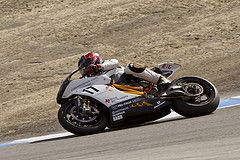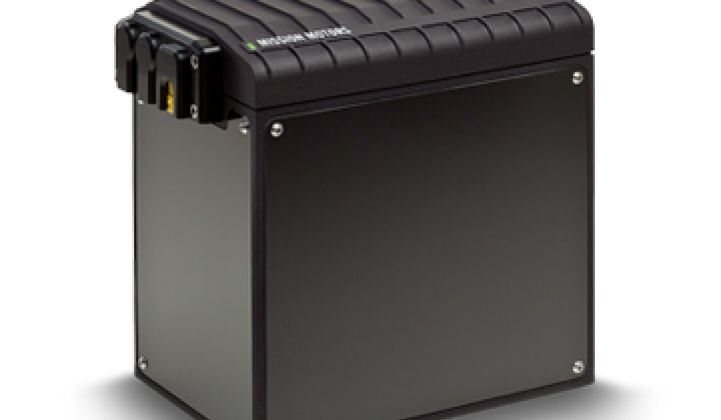Less than 50 percent of the overall volume of a typical electric car battery pack derives from the actual battery cells, he claims. The rest of the bulk comes from the framing, insulation and other components.
Well over 50 percent of the volume of one of Mission’s packs comes from cells. As a result, a prototype of a 1.7-kilowatt-hour battery pack module in Mission’s lobby in San Francisco looks surprisingly small. A person could cradle it with one arm. It weighs 12.5 kilograms and measures 21.8 x 13.5 x 24.5 centimeters. String a bunch together and you get the 14 kilowatt hour battery pack used in one of Mission's racing cycles. Put two cycle packs together and you have a 28 kilowatt hour pack, enough for a decent economy car that could go 100 miles on a charge.
“Every aspect has got to get smaller and lighter and better,” he says.
The company’s induction motors weighs 19.5 kilograms and measures 23.5 x 17 x 19 centimeters. It can hit 15,000 RPMs.
The company started as a manufacturer of high-end electric motorcycles and it still produces two-wheelers to demonstrate and test its technology. But the future of the company will lay in producing modular components -- engines, battery packs, complete drive trains -- for third-party EVs. (Bhattacharya, by the way, will speak further on upcoming initiatives at The Networked EV conference, taking place October 20 in San Francisco.)
Mission started making the shift early last year, in part because there’s only so many people in the world that can afford an electric superbike and very few people in that income category that could safely own one. Another major motivator was the opportunity. Traditional car makers don’t have years of expertise in lithium-ion battery management.
“The expertise [in automotive] has moved from mechanics to electronics,” he said.
It won’t be easy. Traditional auto makers don’t like to bring in outside technology and several companies -- Tesla Motors, for example -- tout a similar strategy. The new 54.5-mile-per-gallon standard, however, could kick-start interest. (This isn't Mission's first transition either. It was originally called Hum Cycles -- go figure -- and Bhattacharya became the drop-in replacement CEO last year.)
Motorcycles turn out to be a handy development platform for cars. Cycle designers put a premium on volume, weight and speed. Weight directly relates to performance in EVs: the heavier a battery pack or motor is, the bigger the impact on acceleration and range.
Motorcycle design also gets designers to focus on things like dampening vibration and the potential for air cooling. Mission’s 14-kilowatt-hour battery pack, which is only two kilowatt-hours smaller than the pack in the Chevy Volt, is actually made up of 1.7 kilowatt-hour modules. The arrangement and spacing of the modules allows for better cooling.
The company does not employ cylindrical cells, but rather uses lithium polymer cells. (It also makes batteries with a 2.6 kilowatt-hour module.)
Bhattacharya wouldn’t discuss contracts or potential partners but says Mission is speaking to all sorts of companies about various designs. The technology could be used in fleet cars, compacts, delivery vans, etc. It will also try to convince early customers to allow the company to persistently and dynamically monitor their batteries to study the state of charge, the performance characteristics in different weather and driving conditions, the temperature changes and other issues.
Does that create privacy issues? Down the road, maybe, but early customers will likely want the data themselves. Fleet owners will be particularly interested because early data can help them devise their EV strategies.
Last year, the company signed a memorandum of understanding with a Chinese manufacturer. That deal has since lapsed. Mission, however, has wiggled its way into some interesting showcase projects.
Honda picked Mission to help it convert a regular CR-Z into a plug-in hybrid. At Thunder Hill, an endurance race, it got second in its class and ninth overall.
At the Red Bull U.S. Grand Prix at Laguna Seca recently, the Mission R, the company race bike, posted a qualifying time of 1:31.3, the fifth fastest for the weekend. In the electric race, the Mission R cut its per lap average time by 10 seconds compared to last year.
Traditional motorcycle fans seemed somewhat surprised.
“You could see a change in the crowd,” he said.



